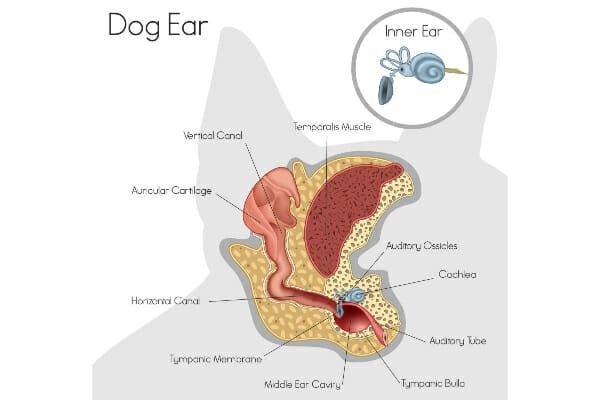Introduction
Dogs have the remarkable ability to hear sounds at much higher frequencies than humans can. This allows them to detect noises that are simply beyond the range of human hearing. Understanding why dogs evolved such sensitive hearing compared to humans provides fascinating insights into the anatomy and capabilities of man’s best friend.
In this article, we will examine the evolutionary history that led to dogs developing superior hearing abilities. We’ll look at the anatomy of a dog’s ear and their impressive hearing range. We’ll also explore how dogs use their hearing for communication, hunting, and working alongside humans. Finally, we’ll discuss causes of dog hearing loss and how to enhance your dog’s hearing as they age.
This topic highlights the amazingly adapted senses of dogs. It’s a chance to appreciate the capabilities of our canine companions and understand how their anatomy equips them for the world in unique ways.
Dog’s Evolutionary History
Dogs evolved from wolves, their ancient ancestors, over the course of 40,000 years through the process of domestication and selective breeding by humans (https://www.akc.org/expert-advice/lifestyle/sounds-only-dogs-can-hear/). Wolves relied heavily on their sense of hearing for survival and hunting prey across vast territories. Their ability to detect faint sounds and high frequencies gave them an evolutionary advantage for tracking prey and avoiding danger.

According to some sources, wolves can hear sounds at frequencies up to 80 kHz, while humans can only hear up to 20 kHz (https://www.reddit.com/r/askscience/comments/2wfuzy/why_can_dogs_hear_more_of_the_frequency_spectrum/). As dogs evolved from wolves, they retained a similar high-frequency range of hearing that helped their wild ancestors. This increased range allows dogs to hear sounds that humans simply cannot detect.
Dogs also evolved as highly social animals that use vocalizations and body language to communicate. Their acute sense of hearing allows them to pick up on the subtle cues and sounds that are part of canine communication. Evolutionary pressure selected for dogs that could hear the diverse vocalizations of their pack members across long distances.
Anatomy of a Dog’s Ear
A dog’s ear consists of three main parts: the outer ear, the middle ear, and the inner ear. The outer ear includes the pinna, or floppy part that you can see, and the ear canal. The pinna funnels sound waves down the ear canal to the eardrum. Dogs have large, cupped pinnae which help capture a wide range of sound frequencies and amplify them as they travel down the ear canal (1).
The middle ear contains the eardrum and three tiny bones called ossicles that transmit sound vibrations to the inner ear. The inner ear contains the cochlea, which is shaped like a snail shell, and is filled with fluid. The cochlea converts sound vibrations detected by the eardrum and ossicles into nerve impulses that travel to the brain. Dogs have an expanded cochlea with two and a half turns compared to humans’ two and a quarter turns, allowing them to hear a wider range of frequencies (1).
The unique shape and structure of a dog’s outer, middle, and inner ear gives them exceptional hearing sensitivity and range compared to humans.
(1) https://www.merckvetmanual.com/dog-owners/ear-disorders-of-dogs/ear-structure-and-function-in-dogs

Hearing Range
Dogs have a much wider range of hearing compared to humans. The average hearing range for adult humans is 20Hz to 20,000Hz. However, dogs can hear sounds from 40Hz to 60,000Hz. This means dogs can detect sounds up to 4 times more than humans can. For example, dogs can hear high-frequency whistles, dog whistles, and even ultrasound frequencies that are inaudible to humans.
The reason dogs have evolved more sensitive hearing is due to their ancestry as hunting animals that needed to detect faint or distant sounds like prey rustling through bushes. Their wide range of hearing allowed dogs to better locate the source of sounds for tracking. Today, dogs still rely heavily on their acute sense of hearing to gather information about their surroundings and remain alert to dangers or other animals.
The higher frequency hearing of dogs also allows them to pick up greater nuance in sounds. They can hear more of the high frequency harmonics in voices which enables dogs to better detect emotional states in human speech. Dogs are able to hear slight differences in tone that indicate anger, sadness, happiness, or other moods that humans cannot perceive in voices.
Additionally, dogs utilize their excellent high frequency hearing for communication with other canines. Many of the whines, barks, and howls that dogs use to interact have dominant frequencies above the range of human hearing. This allows dogs to communicate on channels that humans cannot perceive.
So while humans are limited to a narrow 20Hz to 20KHz hearing range, dogs evolved sensitive hearing that spans 40Hz to 60KHz. This allows dogs to hear critical sounds for hunting, emotional cues in voices, dangers, and canine communication that are inaudible to humans.
Number of Smell Receptors
Dogs have an incredibly powerful sense of smell. A dog’s nose contains up to 300 million smell receptors compared to around 6 million for humans (VCA Hospitals, 2022). With this expansive olfactory system, dogs can detect a wide range of odors that humans cannot perceive (Kokocińska-Kusiak, 2021). The sharp sense of smell allows dogs to gain a wealth of information from scents and is crucial for behaviors like hunting, social interaction, and detecting threats.
In contrast to their exceptional sense of smell, dogs do not rely on hearing to the same degree. While they can detect a wider range of frequencies than humans, their hearing is still limited compared to their olfactory abilities. Hearing is important for dogs in interpreting sounds like commands or prey movement, but smell provides more nuanced sensory information. Overall, a dog’s keen sense of smell far outweighs the importance of hearing for how they experience the world.
Use of Hearing in Communication
Dogs rely heavily on their sense of hearing for communication and social interaction. Barking is one of the most common ways dogs communicate with each other and their human families. The different tones, pitches, and frequencies of a dog’s bark can convey a wealth of information – from alerting to danger, to demanding attention, to announcing a stranger’s arrival [1]. Growling and whining also allow dogs to express important emotional states like anxiety, fear, and contentment.
Perhaps most importantly, a dog’s hearing enables it to understand human speech and commands. According to some estimates, the average dog can learn 165 words, including signals, gestures, and tones of voice [2]. While not capable of abstract thinking, dogs can associate verbal commands with actions and consequences. Their hearing is attuned to pick up on the subtle intonations in their human’s voice that reflect approval, happiness, or frustration.
Howling is also a form of communication for dogs, though scientists still debate its exact purpose. It may be a long-distance way for separated packs to reunite or for broadcasting information about a dog’s location. Either way, dogs rely on their excellent sense of hearing to produce and receive these vocalizations that are key to their social structure.
Hunting and Working Dogs
Certain breeds of dogs rely heavily on their hearing for their working roles, such as hunting dogs, herding dogs, and police dogs. For example, Beagles are scent hounds used for hunting rabbits and other small game. With their large, floppy ears and excellent sense of hearing, Beagles can pick up faint scents and sounds to track their prey (1). Similarly, Border Collies are herding dogs that use their sharp hearing to listen for their shepherd’s whistle commands from far away as they guide and gather livestock (2). Police dogs such as German Shepherds also depend on acute hearing to detect suspicious sounds during search operations or to listen for their handler’s instructions during tense situations (3).
Protecting the hearing of working dogs is crucial so they can perform their duties safely and effectively. Exposure to loud noises like gunshots or equipment can potentially damage their sensitive hearing over time (1). Responsible owners use products like ear muffs and ear plugs designed specifically for dogs when bringing them around loud environments (2). Maintaining good ear health and providing proper hearing protection allows working dogs to fully utilize their exceptional hearing capabilities on the job.

Sources:
(1) https://www.crittear.com/hunting-dogs/protecting-hunting-dogs-hearing-while-allowing-them-to-hear/
(2) https://www.silencercentral.com/blog/the-importance-of-hunting-dog-ear-protection/
Dog Hearing Loss
Hearing loss is common in senior dogs as they age. Gradual hearing loss typically begins around 13 years old, though dogs can experience sudden hearing loss at any age (1). There are several causes of hearing impairment in dogs:
– Age-related hearing loss – This is caused by degeneration of nerves in the ear due to aging. It usually occurs slowly over time.
– Ear infections – Infections and inflammation in the ear can cause temporary or permanent hearing loss if left untreated.
– Exposure to loud noises – Dogs’ sensitive ears can be damaged by chronic loud noises like traffic, machinery, or gunshots (2).
– Some medications – Certain antibiotics and cancer medications can damage hearing.
– Head trauma – Injuries to the head can rupture ear drums or cause nerve damage.
Hearing loss impacts dogs’ quality of life. It can lead to anxiety, confusion, and unresponsiveness. Deaf dogs may startle easily and can be at higher risk of accidents. Training deaf dogs using hand signals and vibration collars can help them thrive. Providing proper ear care and monitoring for infections is also important for senior dogs. With patience and accommodation, hearing loss does not have to mean the end of a happy life for a dog.
Enhancing Your Dog’s Hearing
There are several ways pet owners can help optimize their dog’s hearing abilities and minimize age-related or noise-induced hearing loss:
- Avoid exposing your dog to loud noises like fireworks, gunshots, or concerts which can damage their sensitive ears (Positively, 2021). Use ear protection products made for dogs if unavoidable.
- Clean your dog’s ears regularly to prevent infections and buildup which can impede hearing. Consult your vet on proper cleaning techniques.
- Feed your dog antioxidants like vitamins A, C, and E which may help protect their hearing mechanisms (WagWalking, 2021). Check with your vet before supplementing.
- Keep your dog mentally stimulated with interactive toys and activities to exercise their hearing abilities.
- Teach your dog hand signals along with verbal commands so they can understand you even if their hearing declines.
- Consider a hearing test if your senior dog seems less responsive. Early treatment can help manage age-related deafness.

Paying close attention to your dog’s hearing health and making adjustments as needed will help ensure they can live a happy, enriched life even as they age.
Conclusion
In summary, dogs can hear higher frequency sounds that humans can’t because of key differences in their evolutionary history and anatomy. Dogs have a wider hearing range extending into ultrasonic frequencies above 20kHz. This is due to their ancestry as predators that relied on keen hearing for hunting. Dogs also have more smell receptors and specialized ears that can move independently to locate sounds.
A dog’s superior sense of hearing allows them to pick up high-pitched sounds like dog whistles, squeaky toys, and even rodents scurrying in walls. This acute hearing helps dogs communicate and serves working breeds like hunting dogs well. While hearing loss can affect dogs, especially as they age, there are ways to enhance your dog’s hearing through training and enrichment tools. Understanding the differences between human and canine hearing helps us appreciate our dogs’ unique abilities.
In the end, the evolutionary adaptations that allow dogs to hear ultrasonic frequencies give them access to sensory information humans can’t detect. This explains why dogs sometimes seem to hear things we don’t – it’s because they actually can!
